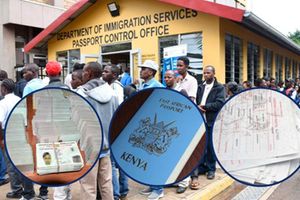New county wealth list

Devolution CS Anne Waiguru with the Swiss ambassador to Kenya, Mr Jacques Pitteloud, and Planning Principal Secretary Peter Mangiti during the launch of the Socio-Economic Atlas of Kenya at Harambee House, Nairobi, on November 10, 2014. PHOTO | EVANS HABIL |
What you need to know:
- The counties with the poorest access to modern services and conveniences are in the North Eastern region.
- But the survey does not capture wealth in the counties such as oil, minerals, tourism establishments, agricultural potential and other resources.
A report has exposed the wide disparities in the quality of life in various counties and the hard work needed to bring modern conveniences to all parts of the country.
While Nairobi is wealthy and many of its residents have access to electricity, sanitation, clean water and other modern tools and toys such as mobile phones and cars, people in other counties are years behind.
In Turkana, for example, 82 per cent of the population do not have access to toilets and must go to the bush. And 97.6 per cent of the residents of the potentially oil-rich county do not have electricity.
In Nairobi, 86.8 per cent have access to improved sanitation and 72.4 per cent have power.
Only 2,000 households, or 1.6 per cent of the households in Mandera, have access to TV and only 1.3 per cent to the Internet.
Comparing highly developed urban centres and remote, arid lands is complicated, but it does show the gap in access to social services and modern technology.
According to the report, is not only the richest of the 47 counties, but is likely to remain so, and perhaps get even richer, the equalising effects of devolution, notwithstanding.
Families living in the capital are way ahead of their counterparts in other regions because they own the highest number of social status symbols such as cars, mobile phones, Internet access at home and clean piped water, among others.
The Socio-Economic Atlas of Kenya also shows that counties at the Coast such as Kwale, Tana River and Kilifi, rank poorly, having, for instance, the highest number of people using paraffin for lighting, with no electricity connection and also have some of the lowest mobile phone and television set ownership.
The counties with the poorest access to modern services and conveniences are in the North Eastern region.
Pockets of the Lower Eastern such as Kitui and Makueni also ranked poorly, while central Kenya generally fared better followed by the Rift Valley, Nyanza, especially Kisumu County, and parts of western Kenya, where counties such as Kakamega and Vihiga were leading in mobile phone connectivity.
FOCUSED ON WELFARE
The survey, launched by Devolution Cabinet Secretary Anne Waiguru on Monday, is likely to spur the push for the devolution of more resources to counties.
Nairobi, the county with the highest population, also has higher potential for growth, with better road connectivity, higher levels of education and other resources.
However, the survey does not capture wealth in the counties such as oil, minerals, tourism establishments, agricultural potential and other resources as it focused on the welfare of the people.
In the individual indices, Nairobi is ahead in number of houses with access to safe drinking water at 82.7 per cent, which translates to about 814,200 households while Narok has the least at 21 per cent, which means only 2,600 houses have safe drinking water in the entire county.
Nairobi also leads with the highest number of households with piped water at 75.7 per cent while Wajir has the least at only 1.5 per cent.
Also, perhaps due to high population, and large number of people living in slums, Nairobi leads with the number of households without access to safe water, at 170,800 while Lamu County in the Coast has the least at only 10,000.
Nairobi also takes the lead with the number of residents with access to improved sanitation at 86.8 per cent of its population, closely followed by Vihiga at 85.6 per cent. Wajir County is the worst at 7.5 per cent.
Nairobi also leads with the number of houses using main sewer, septic tank or cesspool at 57.4 per cent as Bomet leads with number of houses using VIP or covered latrines at 98 per cent.
Makueni has the highest number of persons using uncovered latrines or buckets as toilets at 41.6 per cent, while in Turkana, 82 per cent of the population do not have access to a toilet at all, and residents have to go to the bush.
Homa Bay County leads with the number of households using paraffin for lighting at 94.6 per cent, followed by Siaya at 94 per cent.
Turkana has the least at 26.6 per cent, followed by Nairobi at position 46 with slightly more than one in four households (26.6 per cent) using paraffin for lighting.
Nairobi, however, has the highest number of people with access to electricity at 72.4 per cent of the households, followed by Mombasa at 59 per cent.
Again, Turkana County has the least number of households with electricity connection at 2.4 per cent, while Tana River has the least number of houses within the electricity grid, at only 1,200 houses.
Wajir County tops with the number of houses owned by the families living in them, or owner-occupied dwellings at 95.6 per cent while Nairobi has the least at 13.5 per cent, perhaps due to the high cost of owning homes in the city.
Again Nairobi leads with the number of families owning a motor vehicle at 13.5 per cent of the households, while in Wajir, only 1.2 per cent of the families own cars.
Busia County is the leading with the number of people owning bicycles at 53 per cent, but Wajir again has the least at only 0.4 per cent.
In terms of households owning a radio, Nyandarua takes the lead at 88.2 per cent, while Turkana has the least at 17.5 per cent.
WIDENING WEALTH GAPS
The survey, commissioned in 2011, and covering over 7,000 sub-locations, also has Nairobi County leading in the number of families watching television at 61.6 per cent, and Mandera with the lowest at 1.6 per cent or only 2,000 households, compared to Nairobi’s 606,700.
In an apparent indication of widening wealth gaps, Nairobi, also takes the lead with the number of people owning mobile phones, at 88.3 per cent.
That means there is a mobile phone in 870,200 households in the city. Once again, Turkana was ranked last among the 47 counties.
There, only 15.9 per cent of the households or only 19,000 households, have access to a mobile phone.
Again Nairobi is leading with internet use, the survey concludes, while Mandera County is last with 22.3 and 1.3 per cent of the population having access to the web respectively.
In terms of female-headed households, Samburu takes the lead at 47.5 per cent while Mandera has the least with 18.7 per cent of the households headed by women.
Urban counties such as Nairobi and Mombasa also have a high number of households headed by women. In such areas, the women heads of households are also likely to be well-educated.
In terms of expenditure per person, Nairobi is, once again, tops with a person spending an average of Sh7,230 per month (in 2006 prices), while a person in Wajir spends the least at Sh1,320 per head.
The survey also indicates that in the capital for example, it takes only 30 minutes to travel by road to the nearest city, which is the least amount of time, compared to the least accessible county, where it takes 827 minutes to travel to the nearest city.
There are also a higher population density in Nairobi, at 4,429 people per kilometre of land, compared to the least number, which again is Marsabit, with only four people living on the same land area.
On the number of mothers, who give birth in hospitals, Murang’a County takes the lead, with the least number of births handled by untrained mid-wives at 23.5 per cent.
On the other hand, Nyamira County has the highest number of mothers who give birth without the help of trained professionals at 56.5 percent.
FERTILITY RATE
Mandera County leads in the total fertility rate at 7.5 births per woman, well above the national average of 4.7 births.
Sadly, it also leads in maternal mortality rates at 3,795 per 100,000 births. Wajir, on the other hand, leads in child mortality at 158 per 1,000.
Nairobi and Murang’a counties have the least total fertility rates with three births per woman. Tharaka Nithi has the lowest maternal mortality at 191 per 100,000 births.
The honour for the lowest child mortality goes to Elgeyo-Marakwet where only 42 babies per 1,000 births die at birth.
While launching the Socio-Economic Atlas at Harambee House on Monday, Ms Waiguru, who was accompanied by the Swiss ambassador to Kenya, Mr Jacques Pitteloud, said the data would not only help the government, but also the private sector, and policy makers, in making investment decisions.
“This is the most user friendly economic survey that captures every little detail in a spatial form and is likely to trigger debate about the development levels across the counties,” she said.
Mr Pitteloud said the map avoided the arcane presentation of statistics, saying the information would be accessible to people who are not specialists.





